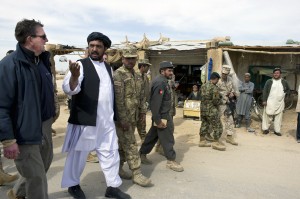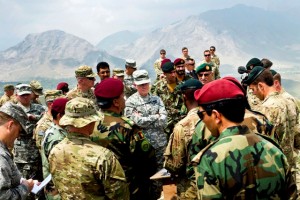Marja Serves as Microcosm of Military Failure in Afghanistan, But Failure is Country-Wide

Deputy Defense Secretary Aston Carter strolls through Marja marketplace on February 24. How many security forces were present out of camera range?
Back in February of 2010, US President Barack Obama’s surge of troops in Afghanistan began its offensive by trying to take the Marja district of Helmand Province. Then US commander of forces in Afghanistan, General Stanley McChrystal famously touted his counterinsurgency program for the area, saying “We’ve got a government in a box, ready to roll in”.
Eight months into the battle for Marja, we had this:
As U.S. involvement in the war enters its 10th year, the failure to pacify this town raises questions about the effectiveness of America’s overall strategy. Similarly crucial operations are now under way in neighboring Kandahar province, the Taliban’s birthplace.
There are signs the situation in Marjah is beginning to improve, but “it’s still a very tough fight,” said Capt. Chuck Anklam, whose Marine company has lost three men since arriving in July. “We’re in firefights all over, every day.”
“There’s no area that’s void of enemy. But there’s no area void of Marines and [Afghan forces] either,” said Anklam, 34, of Fort Lauderdale, Fla. “It’s a constant presence both sides are trying to exert.”
/snip/
The result, so far at least: Residents say the town is more insecure than ever.
“There was peace here before you came,” farmer Khari Badar told one Marine patrol that recently visited his home. “Today, there is only fighting.”
Of course, the Defense Department would have us believe everything is now fine in Marja. They staged a stroll through the marketplace back in February by a Deputy Defense Secretary, presumably to mark the two year anniversary of the offensive. I wonder if this stroll was as heavily protected as John McCain’s 2007 stroll through a Baghdad marketplace.
But even though we are supposed to believe the offensive worked in Marja and the Taliban were routed, there was this from DoD on actions from April 15 of this year: Read more →

